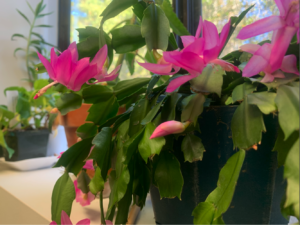Thanksgiving or Christmas Cacti: What Is the Difference & How to Force Rebloom
go.ncsu.edu/readext?970452
en Español / em Português
El inglés es el idioma de control de esta página. En la medida en que haya algún conflicto entre la traducción al inglés y la traducción, el inglés prevalece.
Al hacer clic en el enlace de traducción se activa un servicio de traducción gratuito para convertir la página al español. Al igual que con cualquier traducción por Internet, la conversión no es sensible al contexto y puede que no traduzca el texto en su significado original. NC State Extension no garantiza la exactitud del texto traducido. Por favor, tenga en cuenta que algunas aplicaciones y/o servicios pueden no funcionar como se espera cuando se traducen.
Português
Inglês é o idioma de controle desta página. Na medida que haja algum conflito entre o texto original em Inglês e a tradução, o Inglês prevalece.
Ao clicar no link de tradução, um serviço gratuito de tradução será ativado para converter a página para o Português. Como em qualquer tradução pela internet, a conversão não é sensivel ao contexto e pode não ocorrer a tradução para o significado orginal. O serviço de Extensão da Carolina do Norte (NC State Extension) não garante a exatidão do texto traduzido. Por favor, observe que algumas funções ou serviços podem não funcionar como esperado após a tradução.
English
English is the controlling language of this page. To the extent there is any conflict between the English text and the translation, English controls.
Clicking on the translation link activates a free translation service to convert the page to Spanish. As with any Internet translation, the conversion is not context-sensitive and may not translate the text to its original meaning. NC State Extension does not guarantee the accuracy of the translated text. Please note that some applications and/or services may not function as expected when translated.
Collapse ▲The Christmas cactus is a traditional and very festive gift this time of year. We browse by them in grocery stores, flower shops and many other establishments throughout the holiday season. They have beautiful blooms of white, pink, red, to peach. They make wonderful houseplants but, like many plants that we receive as presents, they require a little care after purchase to keep and encourage return blooming.
There are a couple of things to understand before we can talk about re-bloom in Christmas cacti. First, not all of these plants are Christmas Cacti. Often, we are purchasing a Thanksgiving Cactus (Schlumbergera truncata) not a Christmas cactus
(Schlumbergera bridgesii). The differences between the two are very subtle but make all the difference in blooming.

Thanksgiving Cacti. Photo Credit: Gene Fox
The Thanksgiving cactus is an earlier bloomer by approximately a month (typically around Thanksgiving), making it a better seller for the Christmas season. One of the easiest ways to distinguish between the two plants is to look at the shape of the flattened stem segments called phylloclades. The Thanksgiving cactus has 2 – 4 points or teeth along the margins. Conversely, the Christmas cactus has a lobed or rounded margin. Another way to tell the difference is during bloom. The Thanksgiving cactus has yellow anthers (pollen-bearing structures) and the Christmas cactus will have purple to brown anthers.
So, how do we get them to bloom? I went on a trip in September of this year and so my office stayed closed up and fairly cold from our air-conditioning. I would guess that it was in the high 50’s for the better part of the entire week. Approximately two weeks after I returned from my trip, my Christmas cactus was in full bloom. We can use temperature to force blooms on both the Christmas and Thanksgiving cactus. Keep nighttime temperatures between 50°F and 59°F until buds are set. Do not let them get below 50°F or injury may occur. After bud set, keep them between 60°F and 68°F, preferably closer to 68°. Photoperiod can be manipulated to force bud set as well. Continuous darkness for 13-14 hours each night for approximately 6 weeks will force bud set. Both methods have their limitations. As little as 2 hours of light interruptions could inhibit bud set. If you are using temperature, plants will be injured at temperatures lower than 50°F. Temperature forces bloom regardless of photoperiod. The fool-proof method is using both together!
Propagate between May and June to give these as gifts to your neighbors next Christmas. If you have one or several, they are very easy to propagate to use as gifts for the next season. Simply count 3-4 phylloclades back from the terminal end of the stem and pinch it off at the joint. Allow to sit out in a fairly dark room for 24-48 hours. This allows a callus to form where you pinched it apart from the main plant. This callus helps to stimulate root growth and to protect against rot while roots are forming. Once the callus has formed, plant the callus end of the segment ½” to 1” deep in clean, moist, potting soil. Place the container in bright, indirect sunlight. Roots will form in three to eight weeks and the plant will begin to grow new segments. Once the new growth begins you can transplant into a larger pot. Propagating several at one time will ensure better success.
If you are having trouble with growing in your home landscape, call the Extension office at (252)946-0111 or email Gene Fox at gene_fox@ncsu.edu. Topics begin to get slim this time of year, if you have a question, send it in and I may use it for my next article. Check us out on Facebook (Beaufort County Master Gardeners) for Food Fridays and to see the Plant of the Week. Until then, happy gardening!



